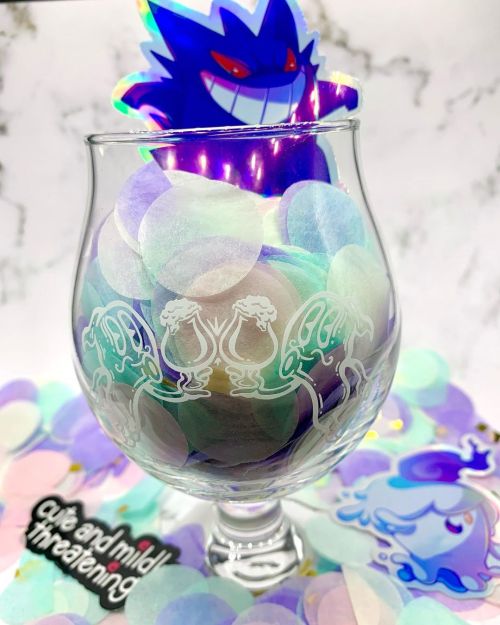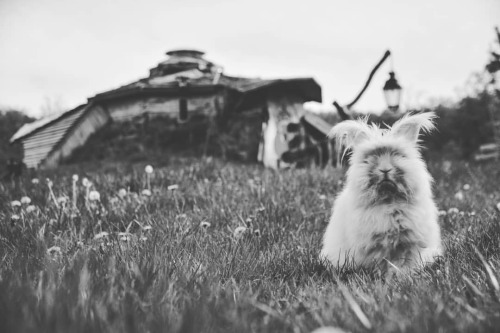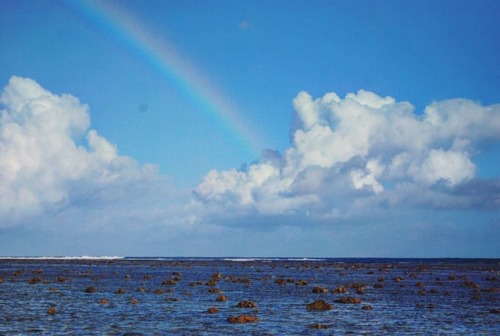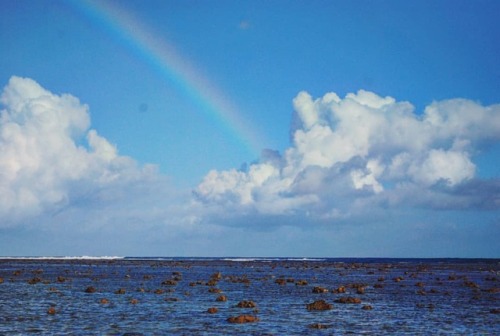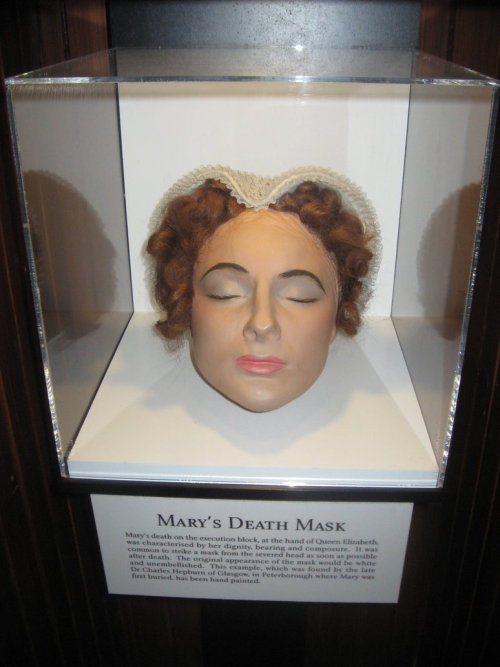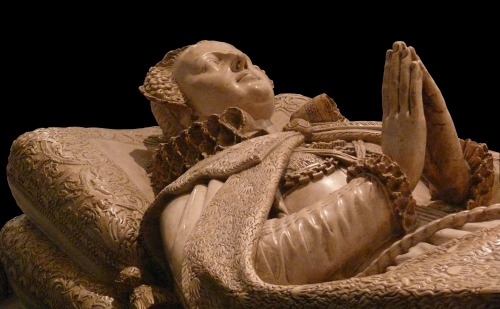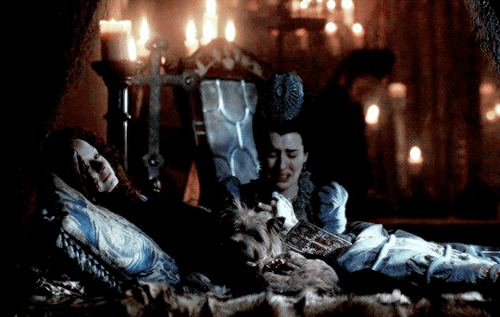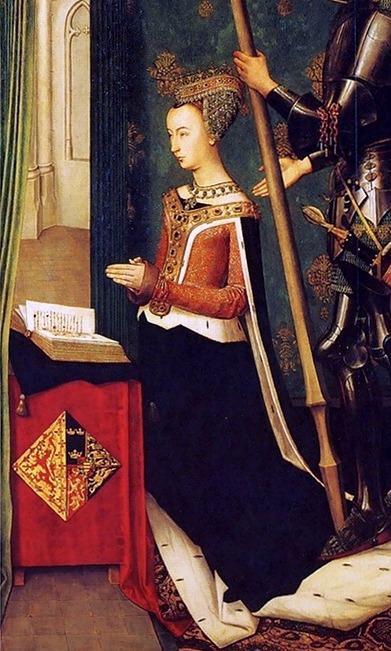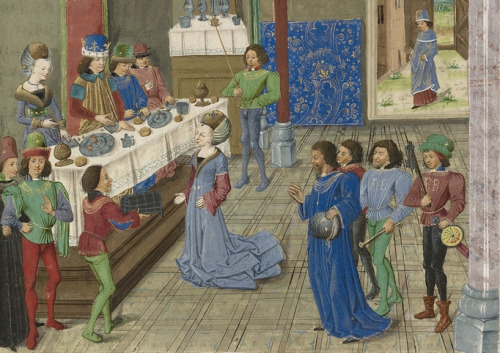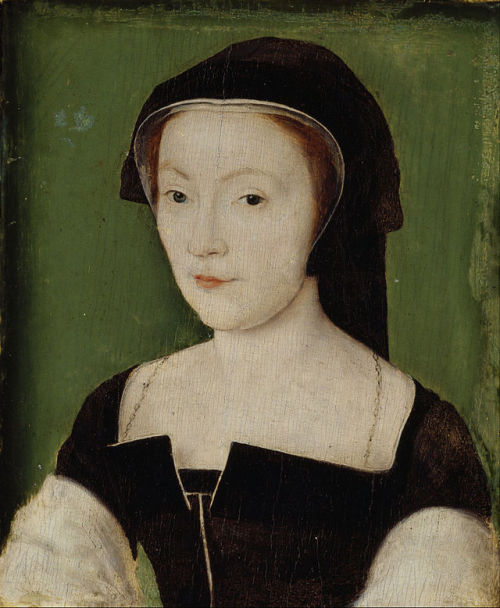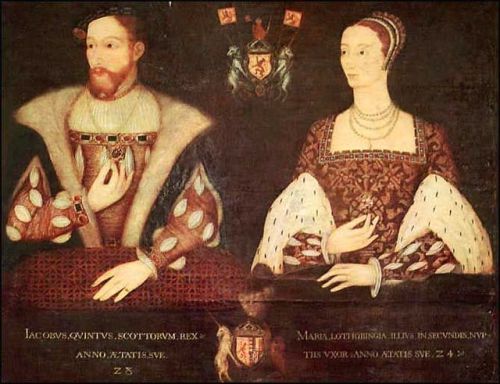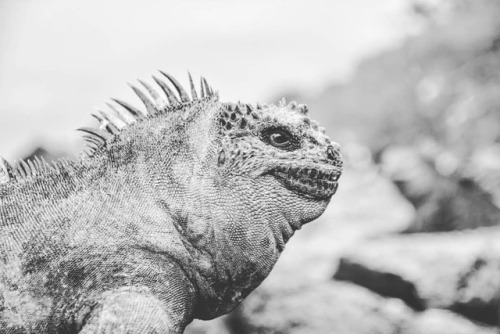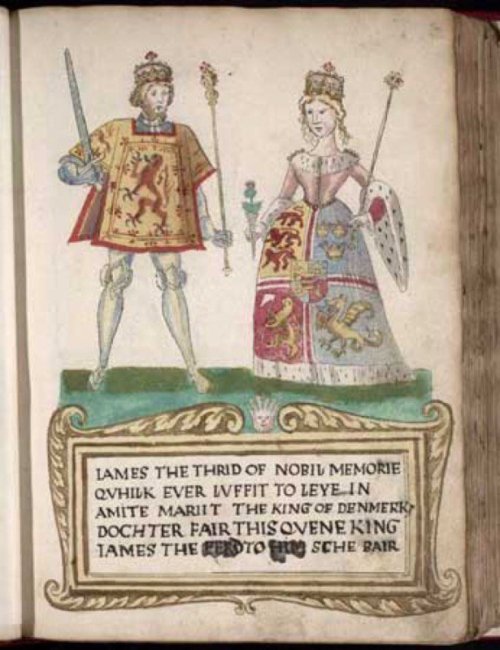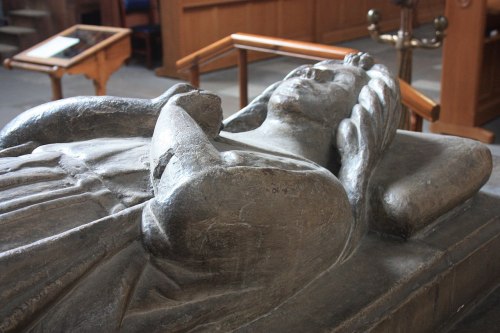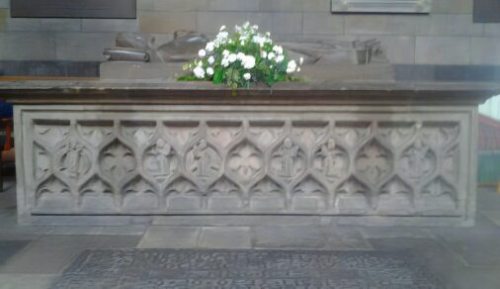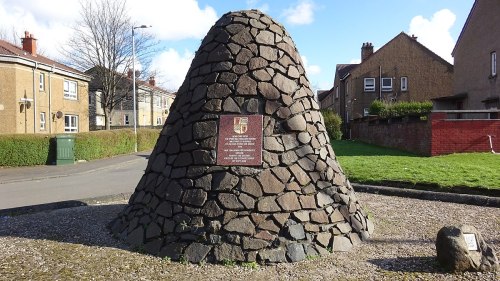#house of stewart
Daniel Mytens - Margaret Tudor, Queen consort of Scotland
circa 1620-1638
oil on canvas
The Royal Collection, Edinburgh
Post link
On February 8th 1587 Mary Queen of Scots was beheaded at Fotheringay Castle.
Pierre de Bourdeille, seigneur de Brantome was a member of the French nobility who accompanied Mary during her internment. He provides us with a sympathetic account of Mary’s execution that begins with the arrival of a delegation from Queen Elizabeth announcing that the former Queen of the Scots is to be executed the next day:
“On February 7, 1587, the representatives of the English Queen, reached the Castle of Fotheringay, where the Queen of Scotland was confined at that time, between two and three o'clock in the afternoon. In the presence of her jailer, Paulet, they read their commission regarding the execution of the prisoner, and said that they would proceed with their task the next morning between seven and eight o'clock. The jailer was then ordered to have everything in readiness.
Without betraying any astonishment, the Queen thanked them for their good news, saying that nothing could be more welcome to her, since she longed for an end to her miseries, and had been prepared for death ever since she had been sent as a prisoner to England. However, she begged the envoys to give her a little time in which to make herself ready, make her will, and place her affairs in order. It was within their power and discretion to grant these requests. The Count of Shrewsbury replied rudely:
‘No, no, Madam you must die, you must die! Be ready between seven and eight in the morning. It cannot be delayed a moment beyond that time.’ ” It was that sudden, very little time for Mary to prepare, a brutal way to spend the last few hours on this earth……..Mary spent the rest of the day and the early hours of the next morning writing farewell letters to friends and relatives, saying goodbye to her ladies-in-waiting, and praying.
At 2 am on Wednesday 8 February 1587, Mary Queen of Scots picked up her pen for the last time. Her execution on the block at Fotheringhay Castle was a mere six hours away when she wrote this letter. It is addressed to Henri III of France, brother of her first husband. The letter was written in French, the following is a translation and is a fascinating insight into the mind of our Queen hours before her murder. Mary had only learnt her fate a few hours earlier.
Note, even though she had been forced to abdicate, and had been a prisoner of her cousin for 19 years, she still called herself, Queen of Scotland.
Queen of Scotland
8 Feb. 1587Sire, my brother-in-law, having by God’s will, for my sins I think, thrown myself into the power of the Queen my cousin, at whose hands I have suffered much for almost twenty years, I have finally been condemned to death by her and her Estates. I have asked for my papers, which they have taken away, in order that I might make my will, but I have been unable to recover anything of use to me, or even get leave either to make my will freely or to have my body conveyed after my death, as I would wish, to your kingdom where I had the honour to be queen, your sister and old ally.
Tonight, after dinner, I have been advised of my sentence: I am to be executed like a criminal at eight in the morning. I have not had time to give you a full account of everything that has happened, but if you will listen to my doctor and my other unfortunate servants, you will learn the truth, and how, thanks be to God, I scorn death and vow that I meet it innocent of any crime, even if I were their subject. The Catholic faith and the assertion of my God-given right to the English crown are the two issues on which I am condemned, and yet I am not allowed to say that it is for the Catholic religion that I die, but for fear of interference with theirs. The proof of this is that they have taken away my chaplain, and although he is in the building, I have not been able to get permission for him to come and hear my confession and give me the Last Sacrament, while they have been most insistent that I receive the consolation and instruction of their minister, brought here for that purpose. The bearer of this letter and his companions, most of them your subjects, will testify to my conduct at my last hour. It remains for me to beg Your Most Christian Majesty, my brother-in-law and old ally, who have always protested your love for me, to give proof now of your goodness on all these points: firstly by charity, in paying my unfortunate servants the wages due them - this is a burden on my conscience that only you can relieve further, by having prayers offered to God for a queen who has borne the title Most Christian, and who dies a Catholic, stripped of all her possessions. As for my son, I commend him to you in so far as he deserves, for I cannot answer for him. I have taken the liberty of sending you two precious stones, talismans against illness, trusting that you will enjoy good health and a long and happy life. Accept them from your loving sister-in-law, who, as she dies, bears witness of her warm feeling for you. Again I commend my servants to you. Give instructions, if it please you, that for my soul’s sake part of what you owe me should be paid, and that for the sake of Jesus Christ, to whom I shall pray for you tomorrow as I die, I be left enough to found a memorial mass and give the customary alms.
This Wednesday, two hours after midnight.
Your very loving and most true sister, Mary RTo the most Christian king, my brother-in-law and old ally.
We rejoin de Bourdeille’s account as Mary enters the room designated for her execution and is denied access to her priest:
“The scaffold had been erected in the middle of a large room. It measured twelve feet along each side and two feet in height, and was covered by a coarse cloth of linen.
The Queen entered the room full of grace and majesty, just as if she were coming to a ball. There was no change on her features as she entered.
Drawing up before the scaffold, she summoned her major-domo (steward) and said to him:
‘Please help me mount this. This is the last request I shall make of you.’
Then she repeated to him all that she had said to him in her room about what he should tell her son. Standing on the scaffold, she asked for her almoner, (chaplain) begging the officers present to allow him to come. But this was refused point-blank. The Count of Kent told her that he pitied her greatly to see her thus the victim of the superstition of past ages, advising her to carry the cross of Christ in her heart rather than in her hand. To this she replied that it would be difficult to hold a thing so lovely in her hand and not feel it thrill the heart, and that what became every Christian in the hour of death was to bear with him the true Symbol of Redemption.”
Standing on the scaffold, Mary angrily rejects her captors’ offer of a Protestant minister to give her comfort. She kneels while she begs that Queen Elizabeth spare her ladies-in-waiting and prays for the conversion of the Isle of Britain and Scotland to the Catholic Church:
“When this was over, she summoned her women to help her remove her black veil, her head-dress, and other ornaments. When the executioner attempted to do this, she cried out:
‘Nay, my good man, touch me not!’
But she could not prevent him from touching her, for when her dress was lowered as far as her waist; the scoundrel caught her roughly by the arm and pulled off her doublet. Her skirt was cut so low that her neck and throat, whiter than alabaster, were revealed. She concealed these as well as she could, saying that she was not used to disrobing in public, especially before so large an assemblage. There were about four or five hundred people present.
The executioner fell to his knees before her and implored her forgiveness. The Queen told him that she willingly forgave him and alI who were responsible for her death, as freely as she hoped her sins would be forgiven by God. Turning to the woman to whom she, had given her handkerchief, she asked for it.
She wore a golden crucifix, made out of the wood of the true cross, with a picture of Our Lord on it. She was about to give this to one of her women, but the executioner forbade it, even though Her Majesty had promised that the woman would give him thrice its value in money.
After kissing her women once more, she bade them go, with her blessing, as she made the sign of the cross over them. One of them was unable to keep from crying, so that the Queen had to impose silence upon her by saying she had promised that nothing of the kind would interfere with the business in hand. They were to stand back quietly, pray to God for her soul, and bear truthful testimony that she had died in the bosom of the Holy Catholic religion.
One of the women then tied the handkerchief over her eyes. The Queen quickly, and with great courage, knelt dawn, showing no signs of faltering. So great was her bravery that all present were moved, and there were few among them that could refrain from tears. In their hearts they condemned themselves far the injustice that was being done.
The executioner, or rather the minister of Satan, strove to kill not only her body but also her soul, and kept interrupting her prayers. The Queen repeated in Latin the Psalm beginning In te, Damine, speravi; nan canfundar in aeternum. When she was through she laid her head on the block, and as she repeated the prayer, the executioner struck her a great blow upon the neck, which was not, however, entirely severed. Then he struck twice more, since it was obvious that he wished to make the victim’s martyrdom all the more severe. It was not so much the suffering, but the cause, that made the martyr.
The executioner then picked up the severed head and, showing it to those present, cried out: 'God save Queen Elizabeth! May all the enemies of the true Evangel thus perish!’
Saying this, he stripped off the dead Queen’s head-dress, in order to show her hair, which was now white, and which she had been afraid to show to everyone when she was still alive, or to have properly dressed, as she did when her hair was fair and light.
It was not old age that had turned it white, for she was only thirty-five when this took place, and scarcely forty when she met her death, but the troubles, misfortunes, and sorrows which she had suffered, especially in her prison.”
The account of Pierre de Bourdeille was originally published in 1665 and republished many times thereafter.
To me her execution was one thing, the way she was treated in death another.
The Queen’s body was embalmed, her entrails secretly buried within the grounds, and she then lay in a lead coffin within Fotheringhay Castle for nearly six months! Queen Elizabeth at last ordered her burial, which was to be in Peterborough Cathedral, denying Mary’s request to be laid to rest in France next to her first husband, King François ll. The Burial Register at Peterbotough contains this entry for the year 1587:
The Queene of Scots was most sumptuously buried in ye Cathedral Church of Peterburgh the first day of August 1587 who was beheaded at Fotheringhay Castell the eight of February before.
The Queen’s body was exhumed 25 years later by her son James l and laid in an ornate marble tomb in Westminster Abbey next to her cousins Elizabeth l and Mary Tudor. What remained of the empty tomb in Peterborough Cathedral was destroyed by Oliver Cromwell’s forces in 1643 when they despoiled the building on their way to attack the Royalist garrison at Crowland.
Post link
✧ Mary always kept dogs, and when she was held a prisoner in England for nineteen years, the queen was allowed to keep her beloved companions with her. As reported by one of her jailors, she would sometimes spend hours talking to her lap dogs; about religion and her estranged son, James. It appears Mary favoured the Maltese and Terrier breeds, and whether it was a Skye Terrier or Scottish Terrier, that stayed by her side during her execution, it was nevertheless, a faithful friend.
Post link
Her first custodian [during her captivity in England], Sir Francis Knollys, said of her, ‘She is a rare woman; for, as no flattery can abuse her, so no plain speech seems to offend her, if she thinks the speaker an honest man.’ She was never distant or reserved as long as her ‘royal estate’ was recognized. She talked a lot, but was bold, pleasant and ‘familiar’. ‘She sheweth a great desire to be avenged of her enemies.’ She abhorred cowardice, whether in friend or foe. ‘She sheweth a readiness to expose herself to all perils, in hope of victory.’ To all other concerns, she was ‘indifferent’.
JOHNGUY,My Heart is My Own: The Life of Mary Queen of Scots
December 1st 1463 saw the death of Mary of Guelders, Wife of King James II.
Mary of Guelders was born circa 1434 at Grave in the Netherlands, she was the daughter of Arnold, Duke of Guelders, and Catherine of Cleves. Catherine was a great-aunt of Henry VIII’s fourth wife Anne of Cleves.
When she was twelve years old, Mary was sent to Brussels to live at the court of her great uncle Phillip, Duke of Burgundy and his wife Isabella of Portugal, where she served as lady-in-waiting to the Duchess of Burgundy’s daughter-in-law, Catherine of Valois, the daughter of Charles VII King of France.
Marie, or Mary as she became known in Scotland had been earmarked to marry Charles, Count of Maine, but her father could not pay the dowry. Negotiations for a marriage to James II in July 1447 when a Burgundian envoy went to Scotland and were concluded in September 1448. Philip promised to pay Mary’s dowry, while Isabella paid for her trousseau. Philip the Good, Duke of Burgundy settled a dowry of 60,000 crowns on his great-niece and Mary’s dower (given to a wife for her support in the event that she should become widowed) of 10,000 crowns was secured on lands in Strathearn, Athole, Methven, and Linlithgow.
William Crichton, Lord Chancellor of Scotland was sent to Burgundy to escort her back and they landed at Leith on June 18, 1449. Her arrival was described by Chronicler Mathieu d'Escouchy. She first visited the Isle of May and the shrine of St Adrian. Then she came to Leith and rested at the Convent of St Anthony. Both nobles and the common people came to see her as she made her way to Holyrood Abbey in Edinburgh.
Marie was 15 and James 19 when the two wed on July 3rd and immediately after the marriage ceremony, Mary was dressed in purple robes and crowned Queen of Scots. Consort by Abbot Patrick.
A sumptuous banquet was given, while the Scottish king gave her several presents. The Queen during her marriage was granted several castles and the income from many lands from James, which made her independently wealthy. In May 1454, she was present at the siege of Blackness Castle and when it resulted in the victory of the king, he gave it to her as a gift. She made several donations to charity, such as when she founded a hospital just outside Edinburgh for the indigent; and to religion, such as when she benefited the Franciscan friars in Scotland. The couple had six children, the oldest James, became James III.
James II died when a cannon exploded at Roxburgh Castle on August 3rd, 1460, before his death he had ordered another castle be built for his wife who was left to oversee it’s construction as a memorial to him, Ravenscraig was still being built when Marie moved into east tower. She also founded Trinity College Kirk in Edinburgh’s Old Town in his memory, she herself died and was buried there in 1483, the old Kirk was demolished, amid protests in 1833 and Marie was interred at Holyrood Abbey.
The pics are of the Queen and their Wedding Feast by Gerard de Nevers
Post link
On November 22 1515 Mary of Guise was born.
After his first French wife (Madeleine of Valois) died, James V planned a second marriage to cement the renewed Auld Alliance. He chose Marie de Guise - a widow with two sons from a brief but happy marriage.
While James V was negotiating for Marie’s hand he had to contend with competition from his uncle, Henry VIII of England. Henry was looking for another wife – he had divorced his first wife Catherine of Aragon, beheaded his second wife Anne Boleyn, and his third wife, Jane Seymour, had died just after giving birth.
Henry’s record of failed marriages meant that Marie’s father refused him and accepted James. Marie de Guise was initially unwilling but relented when James wrote to her directly.
Marie and James had two sons who both died, and one daughter, Mary I (Mary Queen of Scots). Marie de Guise was appointed Regent in 1554, taking over from James Hamilton, 2nd Earl of Arran.
Marie de Guise was Catholic. The rise of the Scottish Protestants threatened her position. When she called on her family in France for help this was seen as proof that she was not loyal to Scotland. She was deposed as regent in 1559.
The first pic is a portrait attributed to Dutch painter Corneille de Lyon, when Marie was around 32, the second is Marie and her second husband, King James V of Scotland, this pic hangs in Falkland Palace, the third a carving by John Donaldson and part of the stunning Stirling Heads at the castle in the town.
More in depth details about Marie de Guise here http://www.maryqueenofscots.net/…/mary-marie-guise-queen-r…/
Post link
The Ladies♔Princesses → Isabella Stewart, Duchess of Brittany (1426 - c.1495/99)
Isabella of Scotland was born in 1426 as the second child and daughter of James I and Joan Beaufort. Although there is no details of her childhood, a report before her marriage describes her as being “a well-brought-up young lady, schooled to silence and submission.” By the age of sixteen she married Francis I, Duke of Brittany in front of Bretons and Scottish nobles on 30th October 1442. The marriage appears to have been cordial and the couple had two daughters. In 1450 Francis died and Isabella was pressured by her younger brother James II to return to Scotland, where he had hoped to arrange a second marriage for her. However, Isabella refused, claiming that she was happy and popular in Brittany; along with being too frail to travel. It was more than forty years later, when Isabella died as early as 1495 and as late as 1499, and lived long enough to see the reign of her grandnephew James IV. She was either buried in Nantes or Vannes.
“In both piety and patronages, she could be matched by others in her world. Her life is of interest, nevertheless, because it provides precious evidence of the tastes of one particular woman, shaped by current fashion in devotion. Beneath the splendid trappings and ceremonial routine appropriate for her rank, Isabella attempted an internal pilgrimage as a private soul, a day by day progress on a path to spiritual enlightenment.” — Elizabeth Ewan and Maureen M. Meikle (editors), Women in Scotland c.1100 - c.1750
Post link
The wife of James III, Margaret of Denmark died on July 14th 1486 at Stirling.
I could have posted about Margaret yesterday the date of her marriage to King James III, but rather than going over the same ground waited for todays anniversary.
Margaret of Denmark was born on 23rd June 1456 as the daughter of Christian I, King of Denmark, Norway and Sweden, and Dorothea of Brandenburg. She had been named after Queen Margaret I, who had ruled Denmark, Norway and Sweden in her own right. There is very little information on Margaret’s youth.
In 1468, the Scottish embassy to Denmark set out. King James III was in need of a wife. King Christian provided his only daughter with a dowry of 60,000 florins of the Rhine. He couldn’t pay the entire sum at once, so he handed over 10,000 florins and pledged his lands and rights in Orkney and Shetland as security for the rest. The dowry was never paid off in full. In return, James settled upon his future wife Linlithgow Palace, Doune Castle and a third of his royal revenues. The marriage treaty was signed on 8 September 1468.
It was too late in the year for Margaret to travel to Scotland and so her departure was delayed until the next spring. She was brought to Scotland by the King’s brother-in-law, the Earl of Arran and probably met her future husband for the first time shortly before their wedding in the Abbey of Holyrood on July 13th 1469.
They went on progress to the north of Scotland and then settled into a routine of moving between the principal residences of Holyroodhouse, Linlithgow, Stirling and Falkland. Margaret gave birth to their first child on 1t7 March 1473. He was the future James IV. He was followed by the birth of two more sons in 1476 and 1479, called James and John. And yes they named their first two boys James, these Stewarts found a name they liked and stuck to it!
Scottish historians praised the Queen’s beauty, gentleness and understanding and considered her sensible. She was very popular in Scotland. Margaret’s biographer suggested she only had sex with her husband for procreation possibly leading James to seek mistresses. They do not seem to have been on the most affectionate of terms but Margaret seems to have always respected James’ position as monarch. James may have been difficult to deal with.
Margaret was quite the fashionable lady and there are records that she had at least 15 gowns, of them six were black, two were purple and two were crimson.
She probably played an important role in the events of 1482, where James was deprived of his power by his brother for a few months. It was probably Margaret who gave the order to besiege Edinburgh Castle to liberate her husband. After these events, they lived mostly separate lives. Margaret preferred to live at Stirling, while James stayed in Edinburgh.
She became ill during the summer of 1486, the usual rumours of poisoning were circulated at this time but it may have been enemies of James who spread the rumours. She died at Stirling on 14th July that year.aged only 30 years old. Even though they were practically estranged, James was deeply affected by her death and endowed daily masses for her soul. He even sent a supplication to the Pope asking for her to be made a saint.
She is buried at Cambuskenneth Abbey, her husband joined her two years later. It is thought the grave was destroyed during the destructive Reformation years following the discovery of two coffins under the site of the high altar during restoration in 1865 that were believed to contain the remains of the royal couple. Queen Victoria paid for the restoration and marker that is in place there now.
Post link
A portrait of Joan Beaufort, Queen of Scots by an unknown artist.
Jane, d. 1445. Queen of James I; daughter of John Beaufort, Duke of Somerset
Gallery: Scottish National Portrait Gallery (Print Room)
Date created: Published 1798
Post link
March 2nd 1316 saw the death of Princess Marjorie Bruce daughter of Robert the Bruce at the age of only 19.
Tying in directly to my last post, Marjorie was the mother of King Robert II.
Marjorie may have been a princess, but her short life was marred by tragedy from her birth, she was the only child of the 1st marriage of Robert The Bruce and was probably born in December 1296, the same eventful month that Edward I of England, the self-styled ‘Hammer of the Scots’, invaded Scotland and laid siege to Berwick.
At the end of June 1306 the 9-year-old princess, together with her stepmother, Elizabeth de Burgh and other women-folk of The Bruce’s family, were sent for safety to Kildrummy Castle, escorted by Nigel Bruce and the Earl of Atholl.
It was intended that they would then move on and take refuge in Orkney until times were easier, but the English army was already at Aberdeen and the royal ladies moved on to Tain, north of Inverness, ehrn they were captured in the sanctuary of St. Duthac and sent south to Edward of England, then at Lanercost Priory in Cumberland. They were separated from each other and Marjorie was sent to a convent, where she remained until her release 8 years later. It is thought she was treated better than some of the others due to her father Richard Óg de Burgh, 2nd Earl of Ulster being one of the most powerful Irish nobles of the late 13th and early 14th, who was a close friend of Edward I.
Not yet 18 at the time of the battle of Bannockburn, 24th June 1314, one of the heroes of that great victory over the English was her second cousin once removed, Walter Stewart, 6th Lord High Steward, some four years her senior, she married in 1315, within a year she pregnant.
Whether through rashness, fearlessness or ignorance of the possible consequences, Princess Marjorie went out riding near Paisley while heavily pregnant. Her horse, taking fright at something, reared up, Marjorie was thrown violently to the ground and immediately went into premature labour. Her only child, the future Robert II, was delivered at the roadside by s crude Caesarean section (the first record of such an operation being performed since the birth of the eponymous Julius Caesar).
The beautiful Marjorie died within a few hours, aged only about 19 years, her last words are reported to have been ‘He’s a laddie; I ken he’s a laddie; he will be king’. Her improbable dying prophecy eventually came true, but not for another fifty-five years.
A cairn at the junction of Dundonald road and Renfrew Road in Paisley is said to mark the area where she fell, it reads…..“Near this spot the princess Marjory Bruce was fatally injured by falling from her horse 1316. Her son born posthumously became Robert the second First of the Stewart kings of Scotland”.
Now that’s the traditional story about Marjorie Bruce, however more recent historians say she may have actually survived the birth of her son, perhaps for as long as 18 years, they can’t agree on this though, some are saying she still died due to coming off a horse, others don’t go into the detail.
Marjorie Bruce was laid to rest in Paisley Abbey
Post link

